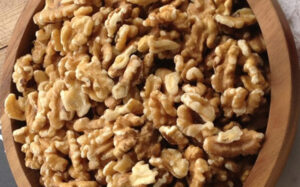WALNUTS

While it is well known that carbohydrate-rich foods are the key influencers of blood glucose (sugar) levels, we now know that other nutrients can influence blood glucose regulation. The Insulin-Index (II) is a classification based on the insulin response of foods. Insulin is the hormone that helps glucose in the blood to be used and stored by the body. High insulin levels are thought to contribute to insulin-resistance and exhaustion of insulin-producing cells – two features of type 2 diabetes and pre-diabetes. Foods with a high II can cause high blood insulin levels after eating and may contribute to increased risk of developing type 2 diabetes in people predisposed to the condition. Having said this, foods with a high II may have advantages in some circumstances such as periods of growth and development like childhood, adolescence or purposeful weight gain such as after illness or athletic body-building.
That’s a long introduction, but here’s where walnuts come in: they are one of the few nuts that have been examined for their impact on insulin levels and the good news is the II for walnuts is low. They do not cause much of a rise on blood-insulin levels when you eat them. We are unable to measure their Glycemic Index (GI) as their available carbohydrate level is too low (3g/100g). A low II is yet another benefit in a long list for this very healthy nut. Walnuts contain dietary fibre, protein, thiamine, vitamin B6, folate, copper, manganese, magnesium and phosphorous. They also contain the highest levels of essential omega polyunsaturated fats, both omega-6 (linoleic acid) and omega-3 (Alpha-linolenic acid) of all nuts. As a whole plant food they also contain a variety of phytochemicals including antioxidants. There is considerable research demonstrating the health benefits of regularly consuming walnuts. They help to lower total and LDL (bad) cholesterol and triglycerides in the blood, which helps to lower heart disease risk. They also have anti-inflammatory properties and may help preserve cognitive function during aging. Their fibre and phytochemicals make them good for gut health.
The best news of all is walnuts are delicious with a more-ish crunch and fabulous shape that look like little brains (yes, in a happy coincidence they’re good for brain health too). I love them straight from the shell after a slow weekend lunch, warm roasted from a fresh nut vendor when out shopping, sprinkled over breakfast, added to a salad (the Waldorf apple, celery and walnut is a classic), on pasta, in baking such as muffins or fruit crumble topping, or on a cheese platter. Give them a light toasting to really bring out the flavour. Walnuts stay fresher for longer in the fridge. This is because their high polyunsaturated fat content, although good for your health, reduces their shelf-life at room temperature. They’re too good to waste so store them well and enjoy them regularly for enjoyment and good health.
| Walnuts | |
| 5 Health Stars | |
| Insulin index 5 | |
| Serving size – 1 handful (30 g or 1 oz) | |
| Kilojoules | 870 |
| Calories | 210 |
| Protein (g) | 4.3 |
| Fats (g) – total | 20.8 |
| Includes: – Saturated fat (g) | 1.3 |
| – Monounsaturated fat (g) | 3.6 |
| – Polyunsaturated fat (g) | 14.9 |
| Saturated : unsaturated fat ratio | 0.07 |
| Carbohydrates (g) – Total | 2.8 |
| Available (Includes): | 0.9 |
| –Natural sugars (g) | 0.8 |
| –Natural starches (g) | 0.1 |
| –Added sugars (g) | 0.0 |
| –Added starches (g) | 0.0 |
| Unavailable (Includes): | 1.9 |
| –Dietary fibre (g) | 1.9 |
| Sodium (mg) | 1 |
| Glycemic load (g) | N/a |
| Diabetes exchanges | 0 |
| Ingredients: Walnuts |








